Guanajuato
On July 11, we left Zacatecas. Breakfast at the hotel started
with instant coffee in styrofoam cups and, so we decided to seek breakfast on the road. But breakfast turned out to be very hard to find! The large restaurant next to
the hotel (with a big DESAYUNO (breakfast) sign on it) was not yet open at
9:00am and we saw little else.
After
passing too fast the perfect "mirador" restaurant on a hill in the desert, we
got discouraged. We stopped in a small town (Ojo Caliente) and found a little
"restaurant" open but when we sat down we learned that they had no milk
and all the eggs were cooked with salsa (which doesn't agree with the
kids. . . . yet). So, back in the car and on our search. We
stopped at the first large place that said RESTAURANT and were
delighted with the perfect breakfast. This day will be remembered
as the one with Helen's dream breakfast. There was a pomegranate
tree by the front door, with flowers and split-open fruits - a good
omen. We sat down at fa ormica-topped table and were immediately
served whole wheat rolls with oats on top and four empanadas filled
with jelly. The coffee was instant, but they had real cups and
milk and it tasted great. We ordered eggs and tortillas and salsa
(on the side) and fruit juice - it was wonderful. They gave the
kids natilla candies as we left.
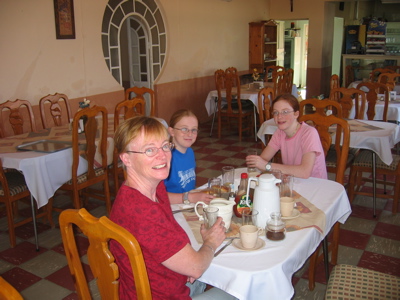
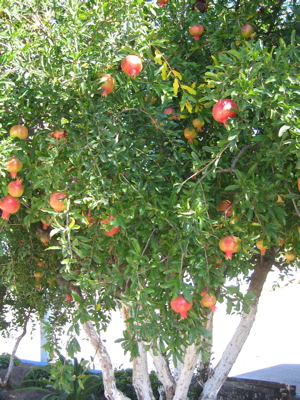
Seen outside the desert town of Ojo Caliente: a grizzled vaquero (cowboy) riding his horse through chest-high cacti in the middle of nowhere-- talking on his cell phone!
Now we were prepared for another drive through the desert, this time to
the small town of Guanajuato, a village founded on silver in 1559.
The town is crammed onto the steep slopes of a ravine, with
narrow streets twisting around the hillside and disappearing into a
series of tunnels. Some of the streets are so narrow that the
balconies of houses on opposite sides of the street almost touch.
We spent the day wandering these narrow streets and alleys,
eating mole (that's mole with an accent on the e; a dark sauce based on
chilis and chocolate) and carne asada on plastic tables in a little
courtyard. The streets were full of color and cobblestones (and
burros. . .)
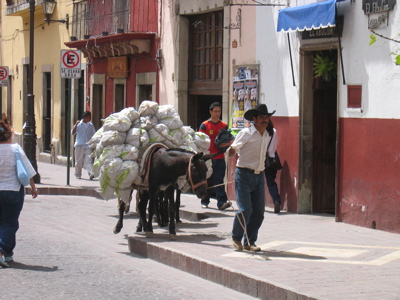
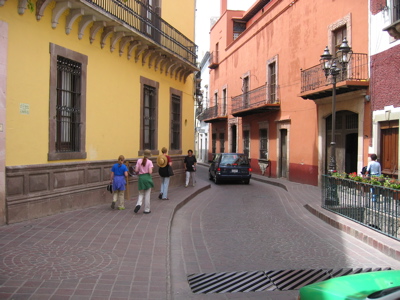
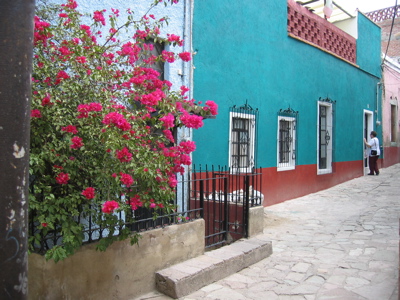
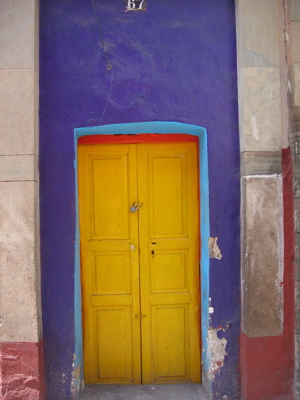

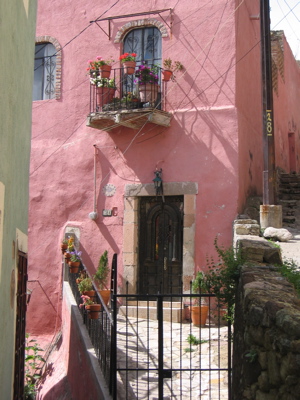
We took a funiculus to the top of a mountain to get a wonderful view of the city:
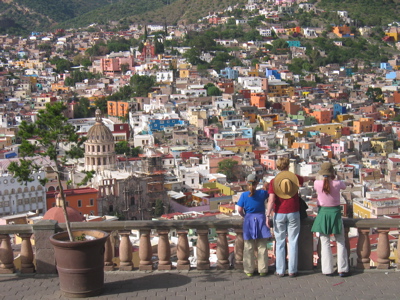
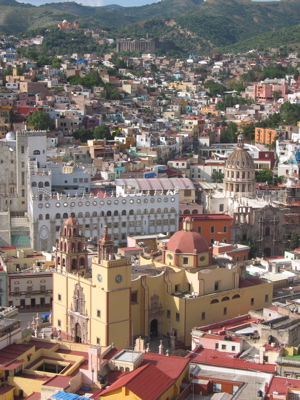
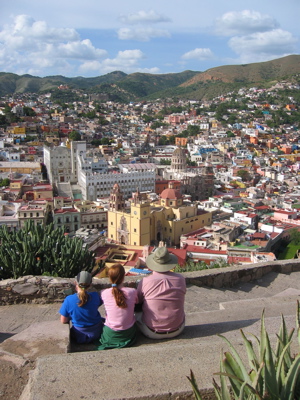
We found the Mercado Central and marvelled at the fruits, vegetables, and animal body parts for sale!
Fruit stand
Chilis
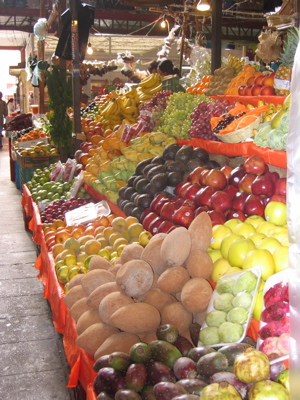
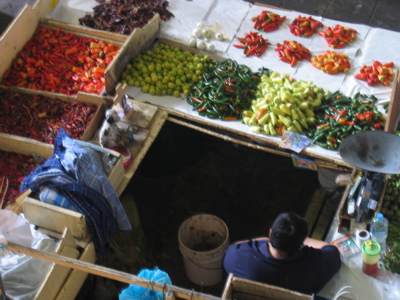
A stall selling only salsas
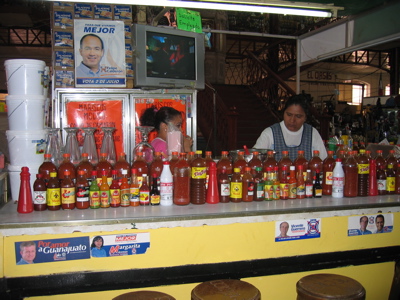
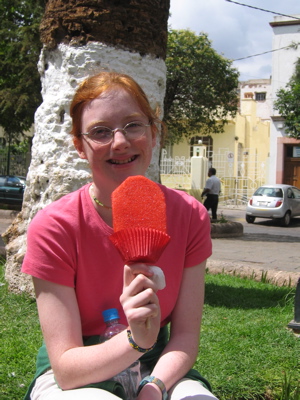 This was the only time Margaret smiled as we tried
jicama-on-a-stick. Jicama is a white, fleshy, moist tuber that is
delicious alone. On this stick they coated the jicama in a pink,
salty, spicy powder that was overpowering! Next time we'll ask
for it plain. . . .
This was the only time Margaret smiled as we tried
jicama-on-a-stick. Jicama is a white, fleshy, moist tuber that is
delicious alone. On this stick they coated the jicama in a pink,
salty, spicy powder that was overpowering! Next time we'll ask
for it plain. . . .
We stayed at the Hotel Embajadores in Guanajuato: a lovely place off
the main center that with a nice restaurant. Helen fell in love
with the leather and wood chairs (below) and it has become her quest to
find some for sale.
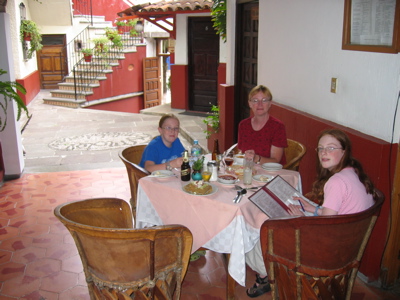
At the end of our stay in Guanajuato, we toured the Mummy Museum.
This was one of the most bizarre experiences in our lives.
The cemetery in town is on one of the steep hillsides; bodies are
entombed in above-ground mausoleums. This cemetery is small and
is too small for the populace of Guanajuato so they disintern bodies to
make room for more freshly dead bodies. The air is sto dry here
that bodes dry relatively quickly and some of the bodies disinterred
are mummies: perfectly preserved bodies, some with stockings still on
their feet. So, rather than putting these perfect mummies to
waste, they put them on display in a museum! We saw mummy after
mummy, rooms of them. The museum claims to have the smallest
mummy (a 6 month-old fetus that was delivered by Caesarean section:
both the mother and baby died in the process). Margaret left
half-way through the tour; the rest of us wish we had. The cab
driver had warned us that it was "bastante horrible" (really gross) and
it was.
And so we left Guanajuato on our final drive to Morelia the town where we will live for the next year.
Next page: arriving in Morelia












 This was the only time Margaret smiled as we tried
jicama-on-a-stick. Jicama is a white, fleshy, moist tuber that is
delicious alone. On this stick they coated the jicama in a pink,
salty, spicy powder that was overpowering! Next time we'll ask
for it plain. . . .
This was the only time Margaret smiled as we tried
jicama-on-a-stick. Jicama is a white, fleshy, moist tuber that is
delicious alone. On this stick they coated the jicama in a pink,
salty, spicy powder that was overpowering! Next time we'll ask
for it plain. . . .

